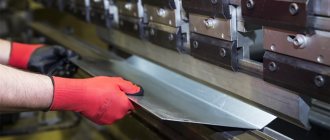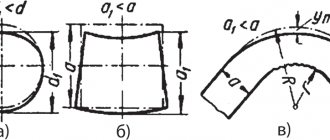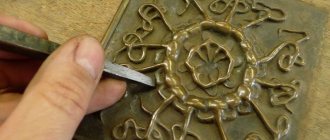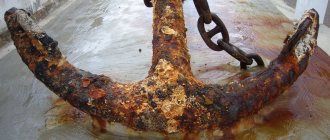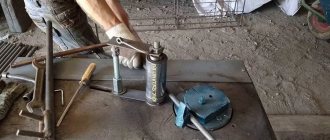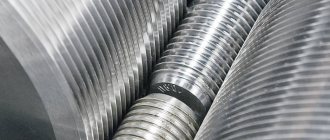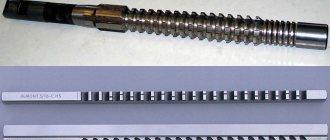Mechanical processing of metal is a physical impact on a metal workpiece in order to obtain a product of the desired geometry with the desired surface quality. You can influence the workpiece using a cutting tool (drill, cutter, cutter, etc.) or using pressure or impact. It is on this principle that mechanical processing of products is divided into two main groups - operations performed without removing and with removal of metal. In the first case, this is pressing, rolling, forging (for non-ferrous metals) and stamping (usually for ferrous metals). In the second case, this is the mechanical processing of parts on machines - cutting. This group includes the following operations:
- turning;
- milling;
- grinding;
- drilling;
- countersinking;
- deployment;
- planing;
- stretching;
- chiselling.
Features of metal processing
Numerous types of metalworking can be classified into one of the large groups:
- mechanical (cutting);
- casting;
- thermal;
- pressure;
- welding;
- electric;
- chemical
Casting is one of the most ancient methods. It consists of melting metal and pouring it into a prepared mold that repeats the configuration of the future product. This method produces durable castings of various sizes and shapes.
Other types of processing will be discussed below.
Machining methods by cutting
| Method | Peculiarities | Equipment used |
| Turning, turning work | The workpiece fixed in the spindle rotates at a certain speed, and the cutter installed in the support performs longitudinal and transverse movements. This is how bodies of rotation in the shape of a cone or cylinder, spiral and helical surfaces are processed. In addition to planing (cutting chips), turning operations include facing, cutting, chamfering, making grooves and processing fillets. | Lathe group machines. |
| Drilling | Making blind or through holes in workpieces of a given diameter and depth, including multifaceted holes. For drilling various metal products, drills made of high-speed steels, drills with hard alloys, borazon, and diamond are used. | Drilling group machines. |
| Countersinking | A type of semi-finishing of materials, in which cylindrical and conical holes in parts are brought to the required size, smoothness and accuracy class. It is performed using solid or mounted countersinks - multi-bladed tools with an axis of rotation. | Drilling and turning machines. Less commonly – boring, milling and aggregate. |
| Grinding | A technology of finishing and finishing metalworking, in which a thin layer of material is removed from the surface of parts. As a result, the products are brought to the required dimensions and a given level of roughness. | Grinding machines with abrasive wheels of different grain sizes, for non-ferrous metals - diamond tools. |
| Milling | It can be shaped, end, peripheral and end. A rotating cutter acts on a longitudinally moving workpiece and grinds out the necessary elements. The cutter moves in several directions and allows you to perform many operations. This is how profiles are milled, grooves, undercuts, keys, wells, cavities and holes are created, chamfers and threads are applied. | Milling machines with a variety of cutters. |
| Gear milling, gear cutting work | A type of blade metalworking, as a result of which involute profile gears are cut with high precision, excellent surface quality, uniform pitch and thread depth. This is how worm wheels, all kinds of parts with straight and oblique teeth, and cylindrical external gears are produced. | Gear hobbing machines with modular hobs. |
| Chiseling | A type of metalworking close to planing. The main tool, the cutter, performs reciprocating movements, giving the workpiece the required dimensions and shapes. It makes keyways, splines, and teeth. | Vertical slotting machines, planing machines, universal milling machines, vertical milling machines with slotting heads. |
Welding
Welding has also been known to man since ancient times, but most of the methods were developed in the last century. The essence of welding is to connect the edges of two parts heated to the plasticity temperature or to the melting temperature into a single integral whole.
Depending on the method of heating the metal, several groups of welding technologies are distinguished:
- Chemical. The metal is heated by the heat released during the chemical reaction. Thermite welding is widely used in hard-to-reach places where it is impossible to supply electricity or haul gas cylinders, including under water.
- Gas. The metal in the welding zone is heated by the flame of a gas burner. By changing the shape of the torch, you can carry out not only welding, but also cutting of metals.
- Electric welding. The most common method: Arc welding uses the heat of an electric arc to heat and melt the work area. Special welding machines are used to ignite and maintain the arc. Welding is carried out using spatter electrodes or special welding wire in an atmosphere of inert gases.
- In resistance welding, heating is carried out by a strong electric current passing through the point of contact of the workpieces being joined. There are spot welding, in which parts are connected at individual points, and roller welding, in which a conductive roller rolls along the surface of the parts and connects them with a continuous seam.
Arc welding
Welding is used to connect machine parts, building structures, pipelines, ship and car hulls, and much more. Welding goes well with other types of metal processing.
Types of metal cutting
| Technology | Peculiarities | Advantages |
| Laser cutting | A focused laser beam melts the sheet precisely along the cut line. | Cost-effectiveness, versatility, high quality edges, precise and thin cutting line, material savings, automatic cutting of any complexity. |
| Plasma cutting | The compressed cutting arc effectively cuts conductive materials: high- and low-carbon, high-alloy and structural steels, stainless steel, cast iron, titanium, bimetals, non-ferrous metals. | Speed and quality of cutting, wide application possibilities, cost-effectiveness. |
| Oxygen gas cutting | A directed jet of technically pure oxygen with a temperature above 1000 °C burns the material along the cut line and blows out combustion products. | Efficient cutting of metal from 5 to 200 cm thick, including medium and low alloy carbon steels from 1 to 200 mm thick. |
| Waterjet cutting | A water jet mixed with abrasive particles is applied to the material under pressure up to 5000 atm. and cuts it at the molecular level. | Creation of parts of complex shapes with precise dimensions. Preservation of physical and mechanical characteristics of the material. Eliminates the risk of deformation. Possibility of cutting all kinds of metals and alloys within a thickness of 300 mm. |
Electrical processing
The method is based on the partial destruction of metal parts under the influence of high-intensity electrical discharges.
It is used for burning holes in thin sheet metal, when sharpening tools and processing workpieces made of hard alloys. It also helps to remove a broken or stuck tip of a drill or threaded tap from a hole.
A graphite or brass electrode, to which high voltage is applied, is brought to the processing site. A spark jumps, the metal partially melts and spatters. To trap metal particles, the gap between the electrode and the part is filled with special oil.
Ultrasonic metal processing
Electrical methods of metal processing also include ultrasonic. High intensity vibrations with a frequency of over 20 kHz are excited in the part. They cause local resonance and point destruction of the surface layer; the method is used for processing durable alloys, stainless steel and jewelry.
What tools are used for this or that technology of machining parts?
There are various options for classifying CNC metal-cutting machines. Depending on what main types of processing they are intended for, CNC machines belong to one of the following technological groups - turning, milling, drilling, jig boring, drilling and milling (milling and boring), drilling and milling and boring, grinding, multi-purpose (multi-operational), machining centers intended for electrical processing, etc.
Depending on the principle of motion control determined by the CNC system, machine tools belong to one of three groups - the first is represented by equipment with CNC positional systems, the second - with contour CNC systems, and the third includes machines with combined CNC systems.
Depending on the number of tools used, machines can be single-tool or multi-tool. Multi-tooling equipment uses up to 12 machines. Those that are able to provide the highest concentration of operations have over 12 instruments. They are equipped with a special magazine to accommodate them. Such equipment is called multi-purpose.
Using multi-purpose CNC machines, a large number of operations are performed with one installation of a part on the machine, which becomes especially important with a significant number of transitions.
It is more expedient to use a console-less layout of medium-sized machines equipped with a cross table and a horizontal or vertical spindle (in the first case, a built-in rotary table is often used).
This arrangement is more rigid in comparison with the cantilever placement of the table, which increases the accuracy of processing, and due to the constant height of the table, the equipment is equipped with devices that allow you to automatically change workpieces. Using single- or double-column CNC machining centers with longitudinal table movement, you can process long parts. This arrangement of equipment is also more rigid in comparison with machines equipped with a cross table.
Machining technologies require that cutting tools experience significant stress, high temperatures, friction and wear, and therefore have special operating requirements. The working part of the tools must be made of materials of great hardness that can withstand increased stress in bending, tension, compression, and torsion.
Also, the materials from which the tools are made must remain hard under the influence of high heating temperatures (have high red resistance). A very important characteristic of a tool material is wear resistance. The higher it is, the slower the wear of the tool will occur and the higher its dimensional stability will be, i.e., the variation in the size of parts sequentially processed with the same tool should be minimal.
Successful technology for machining parts requires as little as possible content of scarce elements in the materials from which cutting tools are made.
- Carbon tool steels
contain 0.9–1.3% carbon. The tools are made from high-quality steels U10A, U11A, U12A. As a result of heat treatment of steel (HRC3 60-62), their red hardness is +200...+250 °C. At this temperature, the hardness of the steel decreases significantly and the tools become unsuitable for cutting. The use of such steels is limited, since the permissible cutting speed cannot be more than 15–18 m/min. They are used for the production of taps, dies, hacksaw blades, etc. - Alloyed tool steels.
They are based on carbon steels alloyed with chromium X, tungsten B, vanadium F, silicon C, etc. The red resistance of such steels (HRC3 62-64) after heat treatment is +250...+300 °C.Alloy steels differ from carbon steels in their increased toughness in the hardened state, higher hardenability, and less tendency to deformation and cracks during the hardening process. The permissible cutting speed varies from 15 to 25 m/min. Broaches, drills, taps, dies, and reamers are made from steels 9ХВГ, ХВГ, ХГ, 6ХС, 9ХС and others.
- High speed steels
containing 8.9–19% W, 3.8–4.4% Cz, 2–10% Co and V. Cutting tools are made from steels R9, R12, R18, R6MZ, R6M5, R9F5, R14F4, R18F2, R9K5 , R9K10, R10K5F2, R10K5F5. The red resistance of heat-treated high-speed steel tools (HRC3 62-65) is +600…+630 °C.The tool is characterized by increased wear resistance and the ability to work at speeds of up to 100 m/min. Tools of simple shapes (cutters, milling cutters, countersinks) are made from P9 steel. Shaped and complex tools (for cutting threads and teeth), which must be highly wear-resistant, are made of P18 steel.
- Cobalt high-speed steels
(R9K5, R18K5F2, R9K10) are suitable for the technology of machining parts in the manufacture of which difficult-to-process corrosion-resistant and heat-resistant steels and alloys were used - they are recommended for use when working in difficult conditions (with heavy intermittent cutting, vibration, poor cooling conditions). - Vanadium high-speed steels (R9F5, R14F4)
are used for the production of tools that are used to perform finishing (broaching, reaming, counterbore). They are suitable for working with parts made of difficult-to-cut materials when cutting chips with a small cross-section. - Tungsten-molybdenum steels (R9M4, R6MZ)
are recommended for the production of tools used for roughing; broaches, cutters and other tools are also made from them. Savings in high-speed steels are achieved through the production of prefabricated and welded tools. For the working part of the tool, high-speed steel is used, welded from carbon steel 45,50,40Х, etc. with a shank. Often, high-speed steel plates are used, welded to toolholders or tool bodies. - Metal-ceramic alloys
are a solid solution containing tungsten, titanium and tantalum carbide (WC, Ti C, Ta C) in metal cobalt (Co).Hard alloys are used in the form of plates produced by powder metallurgy, which have a specific shape and size. The plates are pressed and then sintered at temperatures from +1500 °C to +1900 °C. There is a division of hard alloys into several groups - tungsten is represented by alloys VK2, VKZ, VKZM, VK4, VK4V, VK6, VK6V, VK8, VK8V, VK10, VK15, VK20, VK25; titanium-tungsten includes alloys T30K4D15K6, T14K8, T5K10, T5K12V; titanium-tantalum tungsten - TT17K12, TT10K8B.
Carbide inserts (HRC3 86-92) are characterized by such qualities as high wear and red resistance (+800...+1000 °C), due to which the processing speed can be 800 m/min. The plates are soldered to holders or tool bodies using copper (brass) solders or attached mechanically.
- Mineral ceramics
is a synthetic material, the basis of which is alumina (A12 Oz) sintered at a temperature of +1720...+1750 °C. The red resistance of TsM-332 mineral ceramics (HRC 91-93) is +1200 °C. This material is highly wear-resistant and is used for the production of tools that require high dimensional stability. Due to its slight affinity with metals, the material does not stick to the workpieces.Tools using mineral ceramic inserts are suitable for semi-finishing of parts made of steel and non-ferrous metals under non-impact loading.
To increase the performance characteristics of such instruments, elements such as W, Mo, B, Ti, Ni are added to mineral ceramic plates. Such materials are called cermets. Cermets are of particular importance in the technology of machining parts made of difficult-to-machine steels and alloys.
- Diamonds
belong to a special group of materials. In industry, both natural (A) and synthetic diamonds of the ASO, ASR, ASB, ASC, ACC, ACM, ASN grades are used. This is the hardest material with increased red and wear resistance.Diamond cutters are widely used in such technologies of mechanical processing of parts as fine turning or boring of elements consisting of aluminum alloys, bronzes, brass and non-metallic materials.
Using diamond tools, they work with parts made of hard and semiconductor materials, germanium, silicon, ceramics, heat-resistant steels and alloys. When using such a tool, the quality of processed surfaces increases significantly. The processing speed is over 100 m/min. The surfaces of workpieces treated in this way are characterized by low roughness and high dimensional accuracy, since diamonds are characterized by significant dimensional stability.
Features of artistic metal processing
Artistic types of metal processing include casting, forging and embossing. In the middle of the 20th century, welding was added to them. Each method requires its own tools and devices. With their help, the master either creates a separate work of art, or additionally decorates a utilitarian product, giving it aesthetic content.
Artistic embossing
Embossing is the creation of a relief image on the surface of a metal sheet or the finished product itself, for example, a jug. Embossing is also done on heated metal.
How to choose a technology for machining parts
The manufacture of a particular device or machine requires appropriate production preparation (design, technological, planning and organizational).
The greatest difficulty is presented by the technological preparation of production, which includes the development of technological processes, the design and manufacture of technological equipment (machine and control devices, cutting, measuring and auxiliary tools), the development of various kinds of technical standards, without which planning and organization of production is impossible. To develop technology for machining parts, it is necessary to have:
- working drawings of parts and assemblies;
- technical conditions for the manufacture of parts and assembly of components;
- annual production target, data on the number of parts in the batch;
- technical data of the equipment used (passports, catalogs and descriptions of machines);
- normals for cutting, measuring and auxiliary tools;
- normals for devices and their components;
- standards for technical regulation.
We recommend articles on metalworking
- Steel grades: classification and interpretation
- Aluminum grades and areas of their application
- Defects in metal products: causes and search methods
These initial data form the basis for the development of the technological process, carried out in the following order:
- choosing the type and method of obtaining the workpiece;
- determination of the processing sequence, including a description of operations, settings and transitions;
- drawing operational sketches;
- selection of equipment, devices, cutting, measuring and auxiliary tools;
- determination of interoperational allowances and tolerances;
- design and subsequent production of special devices and tools;
- implementation of technical standardization of operations;
- preparation of relevant documentation.
The economic profitability of the process is indicated when the resulting parts are of high quality and good performance properties, while the costs of their production are minimal. The technological process of machining parts is recorded using route and operational flow charts. Their shape depends on the technological process, type of processing and nature of production.
A sketch of the processing is applied to the operational flow chart, indicating the surfaces involved in this operation, their dimensions and manufacturing tolerances. The map records in what order and with what transitions the work is performed, what machines, devices and tools are used, and indicates all the necessary elements of the cutting mode and piece time standards. Operational technological maps are transferred to the performers, who must have them at their workplaces throughout the entire time required to manufacture a batch of parts.
Successful conduct of the production process is impossible without strict adherence to technological discipline, which consists in the fact that all instructions and requirements included in the technological maps must be strictly followed. Deviation from technological discipline can lead to a high percentage of defective parts, disruption of the rhythm of work and production, and an increase in material costs for the manufacture of products.
Methods of mechanical processing of metals
A large group of methods for machining metals have one thing in common: each of them uses a sharp and hard tool in relation to the workpiece, to which mechanical force is applied. As a result of the interaction, a layer of metal is separated from the part, and its shape changes. The workpiece exceeds the dimensions of the final product by an amount called “allowance”
There are such types of mechanical processing of metals as:
- Turning. The workpiece is fixed in a rotating tooling, and a cutter is brought to it, removing a layer of metal until the dimensions specified by the designer are reached. Used for the production of parts shaped like a body of revolution.
- Drilling. A drill is immersed into a stationary part, which quickly rotates around its axis and is slowly fed towards the workpiece in the longitudinal direction. Used for making round holes.
- Milling. Unlike drilling, where processing is carried out only with the front end of the drill, the side surface of the cutter is also working, and in addition to the vertical direction, the rotating cutter moves both right and left and back and forth. This allows you to create parts of almost any desired shape.
- Planing. The cutter moves back and forth relative to the stationary part, each time removing a longitudinal strip of metal. In some machine models, the cutter is fixed and the part moves. Used to create longitudinal grooves.
- Grinding. The processing is carried out by rotating or performing longitudinal reciprocating movements with an abrasive material that removes thin layers from the surface of the metal. It is used for treating surfaces and preparing them for coating.
Metal grinding
Each operation requires its own special equipment. In the technological process of manufacturing a part, these operations are grouped, alternated and combined to achieve optimal productivity and reduce intra-shop costs.
Machining services from RPM LLC
| № | Type of processing | Execution options |
| 1 | Workpiece selection |
|
| 2 | Turning |
|
| 3 | Milling |
|
| 4 | Slotting |
|
| 5 | Grinding processing |
|
Machining of metal can also be roughing, semi-finishing and finishing - the specific type is selected depending on the dimensions (initial and specified), the required accuracy class and the quality of the processed surface.
As a rule, mechanical processing in mechanical engineering consists of many operations. In the process of turning into a finished product, the workpiece is processed on various machines, sequentially going through all the stages noted in the technological map, which is previously compiled by technologists. Their task is to develop an optimal procedure for processing a workpiece in terms of productivity and cost, taking into account its initial parameters and based on a drawing that indicates all the dimensions, characteristics and accuracy class of the future product. This sequence of operations is called the technological process of manufacturing a part.
Pressure treatment
Metal forming is used to change the shape of a part without compromising its integrity. The following types exist:
- Stamping.
- Forging.
Before forging, the workpiece is heated, supported on a hard surface, and a series of blows are applied with a heavy hammer so that the workpiece takes the desired shape.
Historically, forging was done by hand; the blacksmith heated the piece in the flame of a forge, grabbed it with tongs and placed it on an anvil, and then hit it with a smith's hammer until a sword or horseshoe was made. A modern blacksmith acts on a workpiece with a hammer from a forging press with a force of up to several thousand tons. Billets up to tens of meters long are heated in gas or induction furnaces and fed to the forging plate by transport systems. Instead of a hand hammer, forging dies made of high-strength steel are used.
Forging
For stamping, two forms are required that are mirrored in relation to each other - a matrix and a punch. A thin sheet of metal is placed between them, and then moved with great force. The metal, bending, takes the form of a matrix. For large sheet thicknesses, the metal is heated to the point of plasticity. This process is called hot stamping.
During stamping, operations such as:
- flexible;
- pulling;
- settling;
- and others.
Stamping is used to produce a wide range of products - from household appliance housings to wheel rims and gas tanks.
Pressure machining methods
| Method | Peculiarities | Equipment used |
| Rolling | Used for the production of sheet metal and pipes, shafts, bushings, axles, sleeves, profiles. It can be longitudinal, transverse and transverse helical. | Rolling mill with rotating rolls. |
| Stamping – volumetric and sheet | Changing the shape and size of the workpiece under stamp pressure. Often used in relation to thin sheet metal. The sheet is placed between the matrix and the punch, bent and takes on the required shape. Stamping can be hot and cold, pulse and roll, separating and forming. Varieties of separation stamping are cutting, punching, cutting. Shaping operations of stamping include bending, forming, drawing, crimping and flanging. | Stamping press. Hydraulic or crank press. For cutting – guillotine shears, vibrating and disc machines. |
| Pressing | Extrusion of cold or heated metal on equipment with a replaceable matrix. The material, under the pressure of the press stamp, is extruded through a hole in the matrix and acquires the required shape, density and characteristics. | High pressure presses. |
| Drawing | Creation of products with a given cross-sectional shape. Shaped or round profile blanks are passed through holes of a smaller cross-section, becoming thinner and longer. This is how metal rods, profiles, pipes, and wire are produced. Drawing can be cold and hot, dry and wet, single and multiple, rough and finishing. | Drawing mills. |
| Forging | It involves heating certain areas of the workpiece and their mechanical deformation. The heated metal rod is deformed and takes on the required shape. The result is unique products with high aesthetic qualities. | In the manual method - a hammer, in modern production - a press. |
Processing by cutting
The metal is supplied to the enterprise in the form of rolled products - sheets or profiles of standard sizes and thicknesses. To separate a sheet or profile into products or blanks of the required size, cutting processing is used.
For profiles, cutting with an abrasive wheel or circular saw is most often used.
Several types of cutting are used for cutting metal sheets:
- Manual. A gas welder with a gas torch cuts out pieces of metal of the required size and shape. It is used in small workshops and pilot production.
- Gas. The gas cutting installation cuts with the flame of an automated gas burner and allows you not only to quickly cut sheets, but also to arrange the cut pieces into containers for delivery to assembly areas
- Laser. Cuts metal with a laser beam. It features high accuracy and low waste ratio. In addition to cutting, it can perform welding and engraving operations - applying permanent inscriptions to metal.
- Plasma. Cuts metal with a torch of highly ionized gas - plasma. Used for cutting sheets of hard and special alloys.
Laser cutting
In conditions of industrial production and medium or large series, the concept of metal utilization rate comes to the fore. It is increased both due to a denser arrangement of parts over the area and due to advanced cutting technologies that produce less waste
Equipment used
Mechanical processing is used at specialized enterprises provided with a sufficient amount of production space and the necessary equipment.
To remove surface layers, the product is processed on a lathe and milling machines. The most popular among them are:
- CNC turning centers;
- vertical milling machines.
New models of working fixtures make it possible to maintain high geometry accuracy and surface roughness.
Equipment that allows you to process material mechanically is available in a wide variety. Each enterprise independently decides on the need to purchase a particular device. For example, some industries have rotary machines capable of processing products up to 9 meters in diameter.
The standard equipment that is equipped with any enterprise that processes metal products mechanically includes the following devices:
- milling;
- gear hobbing;
- radial drilling;
- horizontal drilling;
- vertical drilling.
Chemical processing of metals to increase the protective properties of the material
Chemical treatment of metal is the action of special substances on it in order to cause a controlled chemical reaction.
They are performed both as preparatory operations to clean the surface before welding or painting, and as finishing operations to improve the appearance of the product and protect it from corrosion.
Metal galvanizing
Protective coatings are applied using electrochemical treatment using the galvanic method.
Lathe cutting tool
The efficiency that distinguishes work on a lathe is determined by a number of parameters: cutting depth and speed, the amount of longitudinal feed. In order for the processing of a part to be of high quality, it is necessary to organize the following conditions:
- high rotation speed of the workpiece fixed in a chuck or faceplate;
- stability of the tool and a sufficient degree of its impact on the part;
- the maximum possible layer of metal removed during the passage of the tool;
- high stability of all machine components and maintaining them in working condition.
The cutting speed is selected based on the characteristics of the material from which the workpiece is made, the type and quality of the cutter used. In accordance with the selected cutting speed, the rotation speed of the machine spindle equipped with a lathe chuck or faceplate is selected.
Using various types of cutters, roughing or finishing types of turning work can be performed, and the choice of tool is mainly influenced by the nature of the processing. By changing the geometric parameters of the cutting part of the tool, you can adjust the size of the removed metal layer. There are right cutters, which move from the tailstock to the headstock during the processing of the part, and left cutters, which move, respectively, in the opposite direction.
Main types of turning tools
According to the shape and location of the blade, cutters are classified as follows:
- tools with an extended working part, the width of which is less than the width of their fastening part;
- straight;
- bent.
Cutters also differ according to their purpose of use:
- scoring (processing surfaces perpendicular to the axis of rotation);
- pass-through (turning flat end surfaces);
- groove (formation of grooves);
- shaped (receiving a part with a certain profile);
- boring (boring holes in the workpiece);
- threaded (thread cutting of all types);
- cutting (cutting off a part of a given length).
The quality, accuracy and productivity of processing performed on a lathe depend not only on the correct choice of tool, but also on its geometric parameters. That is why in lessons in special educational institutions where future turning specialists are trained, a lot of attention is paid to the geometry of the cutting tool.
Turning tool angles
The main geometric parameters of any cutter are the angles between its cutting edges and the direction in which the feed is carried out. These angles of the cutting tool are called leading angles. Among them are:
- main angle – φ, measured between the main cutting edge of the tool and the feed direction;
- auxiliary – φ1, located, respectively, between the auxiliary edge and the feed direction;
- the angle at the tip of the cutter is ε.
The angle at the tip depends only on how the tool is sharpened, and the auxiliary angles can also be adjusted by installing it. As the main angle increases, the apex angle decreases, and the part of the cutting edge involved in processing decreases; accordingly, the tool life also becomes shorter. The smaller the value of this angle, the larger part of the cutting edge is involved both in processing and in removing heat from the cutting zone. Such cutters are more durable.
Practice shows that for turning not too rigid workpieces of small diameter, the optimal main angle is the value of which is in the range of 60–90 degrees. If you need to process a workpiece of large diameter, then the main angle must be selected in the range of 30–45 degrees. The strength of the tip of the cutter depends on the size of the auxiliary angle, so it is not made large (as a rule, it is selected from the range of 10–30 degrees).
Particular attention in turning lessons is paid to how to choose the right type of cutter depending on the type of processing. Thus, there are certain rules according to which the processing of surfaces of one type or another is carried out using a cutter of a certain category.
- Conventional straight and bent cutters are necessary for processing the outer surfaces of the part.
- A thrust tool will be required for end and cylindrical surfaces.
- A parting cutter is chosen for making grooves and trimming the workpiece.
- Boring cutters are used to machine previously drilled holes.
A separate category of turning tools consists of cutters, with which you can process shaped surfaces with a generatrix line length of up to 40 mm. Such cutters are divided into several main types:
- by design features: rod, round and prismatic;
- in the direction in which the product is processed: radial and tangential.
Screw-cutting lathe 1V625MP
Thermal types of metal processing
Heat treatment of metals is used to improve their physical and mechanical properties. This includes operations such as:
- annealing;
- hardening;
- vacation;
- aging;
- normalization.
Heat treatment of steel
Heat treatment involves heating a part to a certain temperature and then cooling it according to a special program.
Annealing
The workpiece is heated to the plasticity temperature and slowly cooled directly in the furnace.
Annealing reduces the hardness of steel, but significantly increases ductility and malleability.
Annealing
Used before stamping or rolling. During annealing, internal stresses that arise during casting or machining are relieved.
Hardening
When hardening, the workpiece is heated to the plasticity temperature and kept in this state for a certain time, during which the internal structures of the metal are stabilized. Next, the product is quickly cooled in a large amount of water or oil. Hardening significantly increases the hardness of the material and reduces its impact strength, thereby increasing brittleness. Used for structural elements subject to large static and small dynamic loads.
Vacation
Carried out after hardening. The sample is heated to a temperature slightly lower than the quenching temperature and cooled slowly. This allows you to compensate for the excessive fragility that appears after hardening. Used in tool production
Aging
Artificial aging involves stimulating phase transformations in the metal mass. It is carried out with moderate heating to give the material properties that arise during natural aging over a long time.
What it is?
Metalworking (go to services) refers to a broad area - the processing of metal to give it shape, creating parts that are subsequently used for a variety of purposes, from the production of small items to the construction of bridges and ships. In the process, the shape of the original element, its dimensions, and properties change: for example, a separate part can be coated with zinc to give it anti-corrosion properties.
Metal processing is closely related to completely different areas, from decorative to applied, from the creation of interior items to the construction of space stations.
